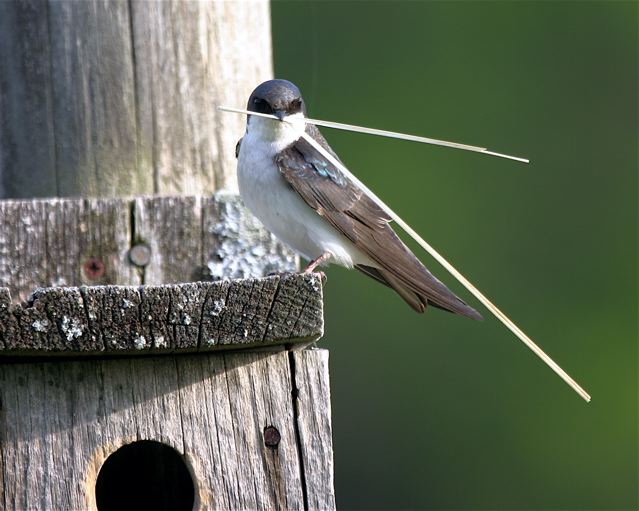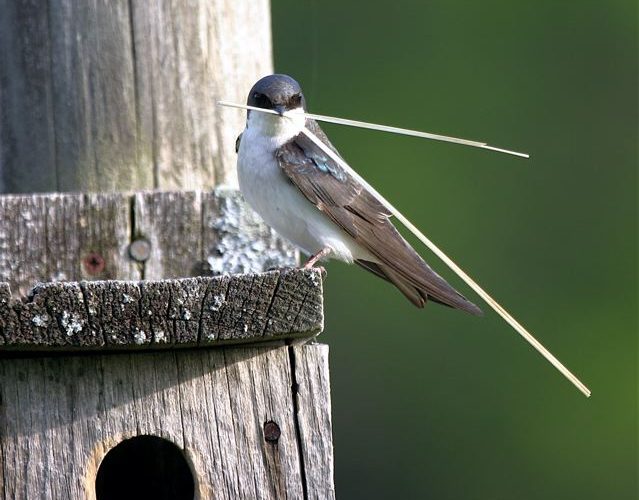
Tree Swallow. Photo by Fred Goodwin.
Carol Decker, director of Ipswich River Wildlife Sanctuary, one of Mass Audubon’s largest sanctuaries located in Topsfield, and David Moon, sanctuary director at Mass Audubon’s Joppa Flats Education Center in Newburyport, spoke to us about what to look for—from birds and bushes to salamanders and frogs—as spring (finally) makes its way here on the North Shore. Here are a few that we’ve rounded up:
Birds
American Woodcock
Also referred to as the timberdoodle, this highly-camouflaged brown bird has been making its way up from southern states since March but is usually hard spot to except in the springtime in “perfect candlelight” conditions, usually around 7:15 p.m.-8 p.m., Decker says, when the males call out to the females by making loud peent sounds and performing aerial displays.
Tree Swallow
Usually spotted adjacent to bodies of fresh water, the tree swallow boasts bright-blue iridescent backs and feeds off insects. Though they generally come back very early in the season, nesting in tree cavities and taking up residence in nest boxes, tree swallows don’t start mating until late July.
Northern Cardinal
Although this bright red bird has been around all winter, within the last few weeks the male has really started to sing. “They’ve been very active—setting up territories and really belting out their mating song,” Decker says. Open your window and listen for one singing!
American Goldfinch
Throughout the winter, the male American Goldfinch is an olive-green color but as spring makes its way here, they turn a bright yellow color and can be spotted more easily in our own backyards.
Skunk Cabbage
Symplocarpus foetidus or skunk cabbage is a beautiful but foul smelling plant that resembles that of Jack-in-the-pulpit. Skunk cabbage can generate its own heat and is able to come through the snow. There is also an enclosed flower within the plant that attracts insects that help pollinate it.
Mourning Cloak Butterfly
These dark colored butterflies have a small band of beige-white colored edges on the upperside. The mourning cloak is one of the Manitoba butterfly species that overwinters as adults, spending their time frozen in dead trees or anywhere that it can fit where their wings won’t get injured. As a result, they are often spotted as early as March. The story behind the species’ name varies but one story suggests the name mourning cloak refers to its resemblance to traditional cloaks worn when one is in “mourning.” Another, as Decker points out, is based on when people used to wait until the ground thawed to bury their loved ones and they would spot these butterflies.
Shadbush
Also called Serviceberry, Shadbush is a large shrub named after the shad fish. As the shad moves up the rivers, this bush blooms simultaneously. Look for white flowers to emerge within the next couple of weeks, Decker says.
Spring Peepers
These tiny little frogs are the size of a thumbnail and although rarely seen can be heard in the spring during mating season. Spring peepers feed on insects and live in moist wooded areas and wetlands, like those found around Boxford.
Spotted Salamander
Spotted salamanders are very rarely seen except in the spring (over 40 degrees) when they come up from underground (they live way down in the soil) and make the one to two-mile trek back to the vernal pool they were born in to mate. Decker notes the importance of having laws in place not to develop vernal pools because spotted salamanders only mate in the pool they were born in. Developing over these pools would prevent spotted salamanders from completing their life cycles and could lead to extinction.
Massachusetts has a program for certifying and protecting vernal pools, so if you spot one visit http://www.mass.gov/eea/agencies/dfg/dfw/natural-heritage/vernal-pools/.
Eastern Chipmunk
Eastern chipmunks are not true hibernators. Instead they enter a torpid state, in which their body temperature and heartbeat decrease, but they wake every few days to feed on stockpiled food, which they sleep on top of, and to defecate. In Massachusetts, they enter their burrows in late October and, except briefly during warm spells (over 40 degrees), they do not emerge until March or April.
“Spring comes in a long series of stages here on the coast,” adds David Moon, sanctuary director at Mass Audubon’s Joppa Flats Education Center in Newburyport. And he adds, there are all kinds of things going on in nature that most people are unaware of.
“Get yourself to a Mass Audubon nature center and start finding out about it,” he says. Until then, look around for these signs of spring on the North Shore.
Blossoms Everywhere
Although lots of flowers bloom in spring, some are especially emblematic of the North Shore and the Great Marsh, which extends from Cape Ann to the New Hampshire Seacoast. In addition to shadbush, beach plums, and black cherries bloom in May, making the region burst with blossoms.
Shorebirds Make Their Debut
Look for birds like woodcock and killdeer early in the spring, when you can hear them singing in wet meadows and neighborhoods, Moon says. Other water birds, like tall, white great egrets (the emblem of the National Audubon Society) and ungainly black cormorants appear a little later in the spring. When trying to spot cormorants, look for flocks flying in a V-shape, similar to how geese fly, but a little, well, messier. “Cormorants are kind of sloppy in that formation,” Moon says. Look for them within 5-10 miles of the Great Marsh and along the Merrimack Rivers.
The Tropics Come to Town
In May, birds from South and Central America arrive on the North Shore, including piping plovers, which nest at places like Plum Island. Also look for Baltimore orioles, scarlet tanagers, and species of tiny, brightly colored, insect-eating warblers.
Birders Are Happy
Of course, where there are birds you can also find birders, and the North Shore is filled with them, especially on Plum Island, which Moon says is one of the best places to see birds in the North East. In fact, he says that on weekends in mid-May, “It’s difficult to drive down the refuge road on Plum Island because there are so many people along the side.” Want to join them? Joppa Flats Education Center regularly leads groups of birdwatchers throughout the year.

